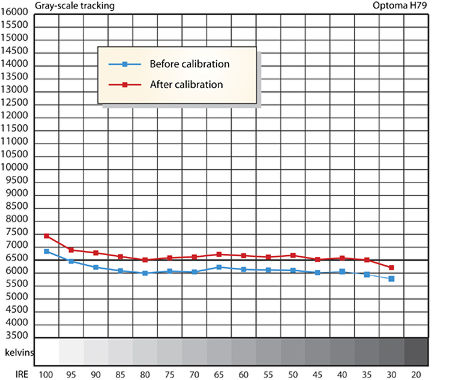Optoma H79 DLP Projector Testing and Calibration
Thomas J. Norton
On multiburst patterns from my AccuPel HDG-3000 HD test pattern generator from either its component or DVI output, the 480i and 480p luminance responses extended out to the highest frequency burst: 6.75MHz for 480i, and 13.5MHz for 480p. Some noise was visible in the 6.75MHz burst in 480i. 720p extended out to 37.1MHz, though with some unevenness visible at that frequency. 1080i, however, did not reproduce 37.1MHz, only the burst below it was clearly reproduced (18.5MHz).
The de-interlacer built into the Optoma performs its de-interlacing function as well as any de-interlacing technology we've seen built into a projector. It quickly captured the unflagged 3:2 pulldown on my Faroudja test DVD, handled the waving flag without a trace of jagged edges, and showed no lines or blurring on mixed content (film-over-video or video-over-film). On the HQV Benchmark test DVD it passed both jagged-edge tests with excellent scores, displayed good resolution on the detail test, had very low noise, and passed the difficult bleacher test after taking about a half-second to lock onto the image.
The projector would not, however, accept a 480i DVI input, so if you use the DVI input for DVD, you will be limited to the performance of the de-interlacer built into the player with a 480p connection, and also the scaler, if you set up the player for a 720p DVI output.
All of my measurements were, by necessity, made on a projector with a limited time on the lamp (just over 30 hours) This was a different sample from the one Steven auditioned. After calibration, I measured a peak contrast (peak full-field white vs video black) of 1926 (15.41 foot-Lamberts peak white, 0.008fL video black) on my 78-inch-wide Stewart Studiotek 130 screen.
Overscan with the DVI input measured at or below 1% on all sides. As Steven noted and I confirmed, the projection lens was essentially free of chromatic aberration (viewed at the maximum throwing distance).
The green and blue color points, while not spot-on to the standard, were as near to accurate as we have measured on most DLP projectors. The reds, on the other hand, were quite deep, rich, and more extended than the standard. While not at all unpleasant or unnatural-looking, they weren't an accurate representation of the source material.
The color temperature measurements are shown in the chart. Changes to the color temperature made in the user Advanced Adjustment menu were global—they modified all three preset color temperature selections.

The before readings shown were taken with the color temperature set to 1. This setting was actually the closest to accurate out-of-the-box, but with an excess of green and a droop in color temperature at very low light levels. However, even after calibration there was a subtle but noticeable red push at the dark end, giving flesh tones in dimmer scenes a slightly ruddy glow.
Comment: I agree with Steven's comments about the Optoma's in-normal-use performance. While the H79 can't quite match the best black levels, gray-scale tracking, and detail I've seen in a few considerably more expensive DLP projectors, it provides a consistently fine image.
If I have any complaints at this price level, they are picky ones. I'd like to see color and hue controls on the DVI input. They aren't strictly required, or even theoretically necessary, with DVI, but I've found them useful. Many other projectors provide them.
The manufacturer also went to a lot of effort to design the case to keep stray light from escaping, then installed several bright indicator lights on the outside!























































